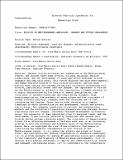Por favor, use este identificador para citar o enlazar a este item:
http://hdl.handle.net/10261/78823COMPARTIR / EXPORTAR:
 SHARE SHARE
 CORE
BASE CORE
BASE
|
|
| Visualizar otros formatos: MARC | Dublin Core | RDF | ORE | MODS | METS | DIDL | DATACITE | |

| Título: | Erosion in Mediterranean landscapes: Changes and future challenges |
Autor: | García-Ruiz, José María CSIC ORCID ; Nadal-Romero, Estela CSIC ORCID ; Lana-Renault, Noemí CSIC ORCID; Beguería, Santiago CSIC ORCID | Palabras clave: | Erosion Badlands Land use changes Intensification Land abandonment Mediterranean landscapes |
Fecha de publicación: | 6-jun-2013 | Editor: | Elsevier | Citación: | García-Ruiz JM, Nadal-Romero E, Lana-Renault N, Beguería S. Erosion in Mediterranean landscapes: Changes and future challenges. Geomorphology 198: 20-36 (2013) | Resumen: | [EN] Intense erosion processes are widespread in the Mediterranean region, and include sheet wash erosion, rilling, gullying, shallow landsliding, and the development of large and active badlands in both subhumid and semi-arid areas. This review analyses the main environmental and human features related to soil erosion processes, and the main factors that explain the extreme variability of factors influencing soil erosion, particularly recent land use changes. The importance of erosion in the Mediterranean is related to the long history of human activity in a region characterized by low levels of annual precipitation, the occurrence of intense rainstorms and long-lasting droughts, high evapotranspiration, the presence of steep slopes and the occurrence of recent tectonic activity, together with the recurrent use of fire, overgrazing and farming. These factors have resulted in a complex landscape in which intensification and abandonment, wealth and poverty can co-exist. The changing conditions of national and international markets and the evolution of population pressure are now the main drivers explaining land use changes, including farmland abandonment in mountain areas, the expansion of some subsidized crops to marginal lands, and the development of new terraces affected by landslides and intense soil erosion during extreme rainstorm events. The occurrence of human-related forest fires affecting thousands of hectares each year is a significant problem in both the northern and southern areas of the Mediterranean basin. Here, we highlight the rise of new scientific challenges in controlling the negative consequences of soil erosion in the Mediterranean region: 1) to reduce the effects and extent of forest fires, and restructure the spatial organization of abandoned landscapes; 2) to provide guidance for making the EU agricultural policy more adapted to the complexity and fragility of Mediterranean environments; 3) to develop field methods and models to improve the identification of runoff and sediment contributing areas; 4) to contribute to the conservation of landscapes (i.e. bench-terraced fields) having high cultural and productivity values; 5) to improve knowledge of the hydrological and geomorphological functioning of badlands, with the aim of reducing sediment yield and accessibility; 6) to better understand the effect of climate change on soil erosion in the Mediterranean region; and 7) to improve quantitative information on long-term soil erosion. | Descripción: | The definitive version is available at: http://www.sciencedirect.com/science/article/pii/S0169555X13003073# | Versión del editor: | http://dx.doi.org/10.1016/j.geomorph.2013.05.023 | URI: | http://hdl.handle.net/10261/78823 | DOI: | 10.1016/j.geomorph.2013.05.023 | ISSN: | 0169-555X | E-ISSN: | 1872-695X |
| Aparece en las colecciones: | (EEAD) Artículos (IPE) Artículos |
Ficheros en este ítem:
| Fichero | Descripción | Tamaño | Formato | |
|---|---|---|---|---|
| GarcíaRuiz_Erosion in Mediterranean landscapes_Geomorphology2013.pdf | 761,36 kB | Adobe PDF |  Visualizar/Abrir |
CORE Recommender
SCOPUSTM
Citations
262
checked on 13-abr-2024
WEB OF SCIENCETM
Citations
232
checked on 26-feb-2024
Page view(s)
523
checked on 17-abr-2024
Download(s)
841
checked on 17-abr-2024
Google ScholarTM
Check
Altmetric
Altmetric
NOTA: Los ítems de Digital.CSIC están protegidos por copyright, con todos los derechos reservados, a menos que se indique lo contrario.
